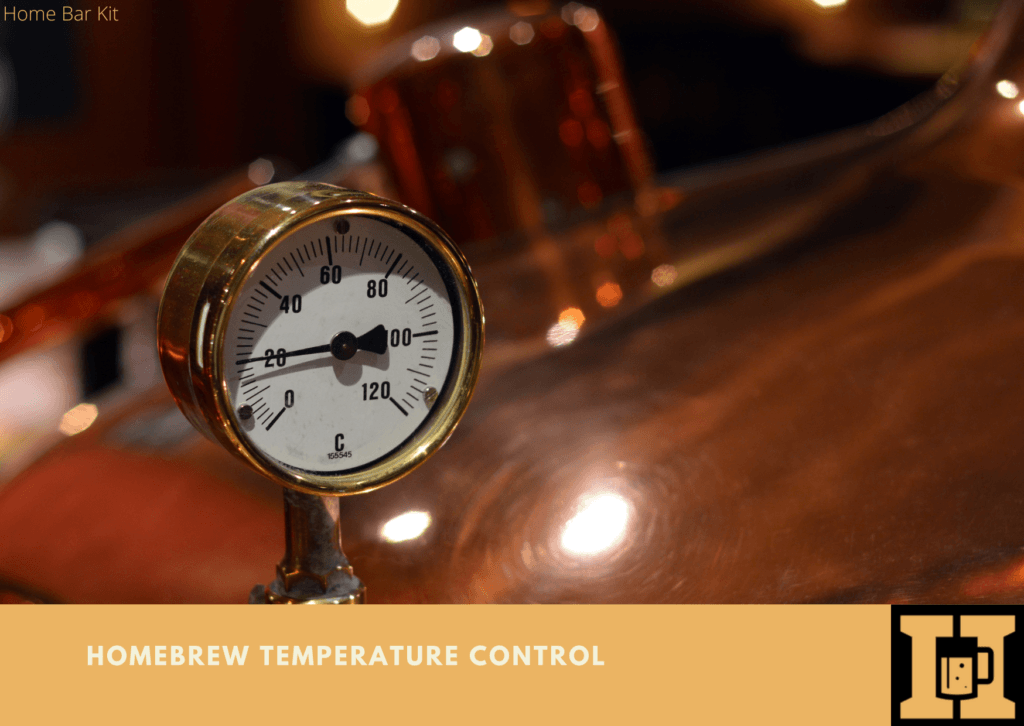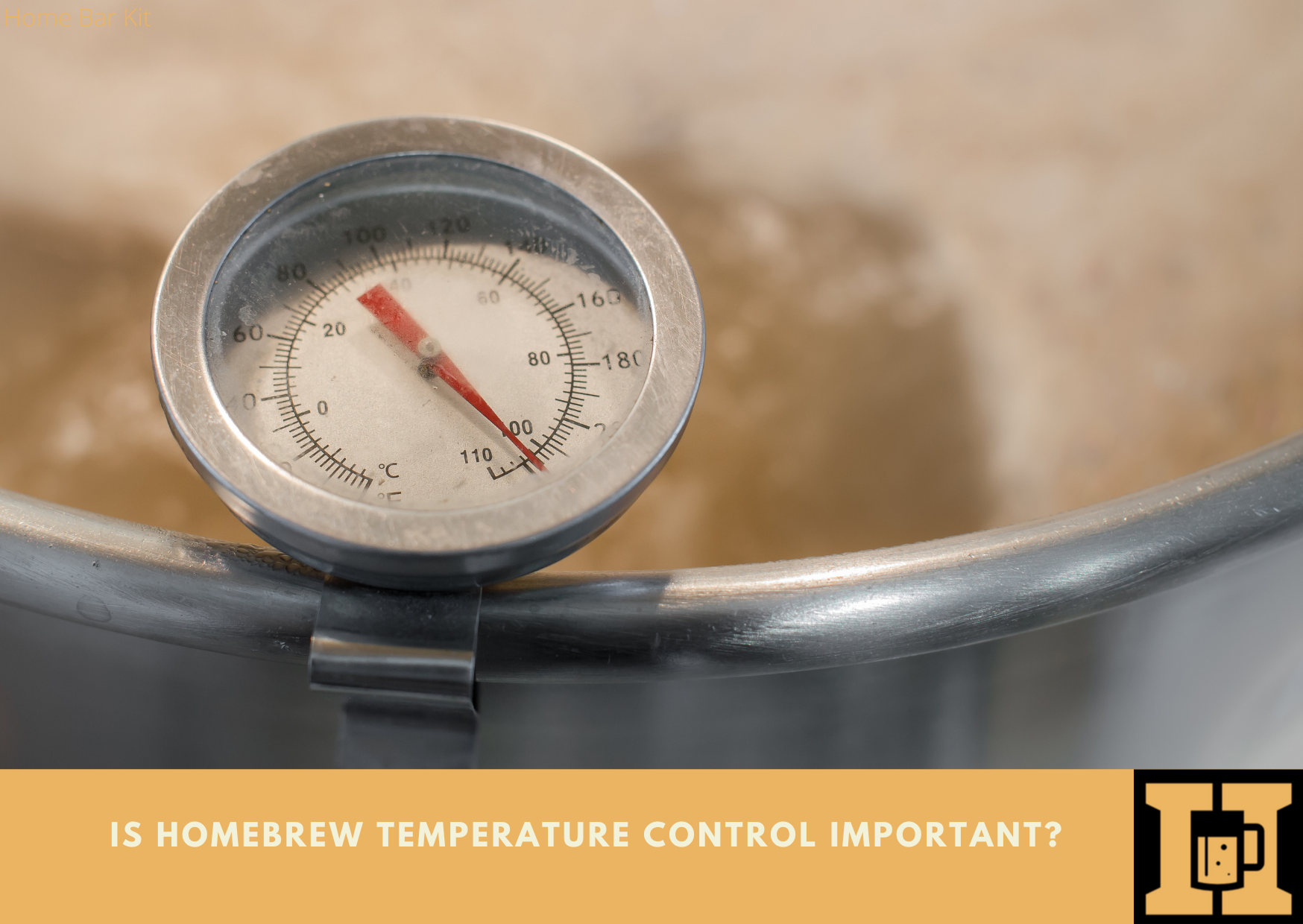Is homebrew temperature control important? Well so I have heard, yes it is important. And if you love beer then there is always a temptation to brew your own. How do I know this? Because I love beer and I am always tempted to brew my own. But can this temperature control thing put you off brewing?
After all if you get it wrong, then your beer is not going to be worthy of drinking. No one wants to brew beer and then find out it is not drinkable, kind of defeats the object of brewing. In this article I want to find out why temperature control is important, and how to control it.
Homebrew temperature control is important, when brewing beer a constant temperature needs to be maintained during the fermentation process. Too cold and the fermentation will be sluggish and may even stop completely. Too warm and the beer may end up with off flavors. The right temperature for ales is between 68°F (20°C) and 72°F (22°C).
That may be the sweet spot for ale as depending on what source you read it can vary by a few degrees.
Is Homebrewing Worth It?

On the face of it you would expect homebrewing to be worth the effort. Especially with the advancement in brewing equipment.
I guess it depends on how far you go with it. Equipment can be expensive, as can ingredients to make your brew.
If you are turning your garage or shed into a microbrewery, and buying all the ingredients separately, then it may take a lot of investment. It will also take a fair amount of skill, so a lot of trial and error may be involved at the start.
However if you are going for a basic brewing kit with the ingredients already to go, then the investment is minimal. This also the best place to start for beginners.
The first batch of beer will be more expensive because of the kit outlay. However the second batch only requires the ready to use beer kit ingredients.
This means cheap beer, however does it mean cheap flavor too.
Brewing My Own Beer
As a beer lover I have often been tempted to brew my own beer. I have done it in the past (early 80s) and I think it was mediocre at best.
Things have moved on and the beer kits available now make the whole process easier. So I have jumped in and bought my brewing starter kit along with an American Pale Ale beer kit.
It should arrive by the weekend, and I can get brewing. In the meantime I have been reading up a little on the basic brewing process. All of it seems to be pretty straightforward, however the one thing that is slightly worrying is the fermentation temperature.
There are ways of combating this, and I will go into them. However at the moment I am reluctant to spend the time and cash on these for a first brew.
So is the wrong temperature really going to muck up my beer?
Why Is Fermentation Temperature So Important?

This is not just for the pale ale that I am brewing, this goes for lagers, ciders and wine too. Temperature control is something that needs to be taken into account when brewing.
When I brewed years ago, I am sure we just put the fermenter in the airing cupboard and let it do its thing. These days there are fermenting chambers, brew jackets and heat belts or pads.
The ambient temperature of a garage or spare room can not be trusted to be the right temperature all the time. The fluctuations in temperature may spoil the beer.
What Happens If The Fermentation Temperature Is Too Cold?
When you ferment with the temperature too cold, apparently you can stress the yeast. No one wants their yeast to be stressed. The fermentation may become sluggish and continue for a longer period. It could even stop altogether.
Some say a result of this is unfermented sugars ending up in the end product. Which can continue to build pressure once bottled. Worse case scenario is exploding bottles.
When fermenting ale too cold you may lose aromas and flavors that would normally develop during fermentation at the right temperature. This could result in a beer that is too clean for the style you are brewing.
So that is all a bit worrying, however others don’t seem to be too concerned. If your fermentation is a little cold and has stopped, move it to a warmer environment. Then give it a little shake and it will get back under way, no harm done.
What Happens If The Fermentation Temperature Is Too Warm?
When your fermentation temperature is too warm it can send your yeast into a frenzy. No one wants yeast going all crazy. It can become over active and run out of steam before fermentation is complete leaving unconsumed sugar.
The over active yeast can also produce by products that result in off flavors, or flavors that should not be in the style of beer being brewed.
I guess getting the sweet spot is important to get the right result for the beer you are brewing. Too cold and it will take longer to ferment or stop altogether. Too warm and it will ferment to quickly and possibly die off.
Different yeast will have different temperature ranges, so checking the temperature of the yeast you are using is important too.
Does Yeast Produce Heat?
During the early days of fermentation yeast can produce heat. This is something to take into account when looking at getting the right temperature at the beginning.
Although the ambient temperature in your fermenters location may be right. Inside the fermenter may be several degrees higher. This means the fermentation could be progressing to quickly because it is too warm.
So there is a lot to take into account when your beer starts to ferment.
“As an Amazon Associate I earn from qualifying purchases.”
Homebrew Temperature Control

I have been looking into ways in which I can control the temperature of my homebrew. I know which method I will eventually use, but I cannot make that happen on this brew.
So I will have to use one of the other methods, or at least adapt one to suit my situation.
There seems to be plenty of gadget to warm up the fermenter, but not as many to cool it down. Unless you want to chuck a load of money at it.
I will look at the cooling methods first, which to be honest are a little hap hazard an I suspect a little unreliable.
Swamp Cooler
Supposedly works similar to an air condition unit and is referred to as evaporative cooling. So can be used to cool down and maintain the fermenter.
This consists of a large bucket/container big enough to fit the fermenter in. A T-shirt and a fan.
Place the fermenter in the container and add water to the height of the beer level. Drape a wet T-shirt over the fermenter and make sure it touches the water. Direct a fan at the container to keep the fermenter cool.
Apparently this is said to keep the beer several degrees below the ambient temperature of the room.
Ice Bath
A similar set up but without the T-shirt and fan, and with the addition of ice packs.
Place the fermenter into the container and again add the water. Now add ice packs to keep the water temperature down, which will also keep the fermenter cool too.
Just using ice cubes would be a nightmare as they would melt too quickly. So either ice packs or 2L plastic bottles filled with water and then frozen.
Obviously the ice packs would have to be changed regularly to maintain a cool temperature.
These two methods to me are a little hit and miss, and just too fussy.
Cooler Bag
“As an Amazon Associate I earn from qualifying purchases.”
The Cooler Bag is basically the same principal as a cool bag for your beers to keep them cool. A large aptly shaped cooler bag that is insulated and your fermenter sits in.
You can then add ice packs or iced plastic bottles inside to keep your fermenter temperature cool. Again you would have to swap out the ice packs regularly to maintain a cool atmosphere.
This seems an easier process than the swamp cooler or ice bath. A little more contained and tidy.
But what about if you need to heat up your fermenter a little.
Heat Belt
This is exactly what it sounds like, a belt that wraps around your fermenter and heats up to bring up the temperature of your beer.
They obviously plug into a socket outlet, and will keep a constant temperature. Most Heat Belts I have looked at seem to have good reviews. So I think they are a good bit of kit to have if you need to up the temperature of your brew.
Heat Pad
Again the same principle as the heat belt, but instead of a belt you wrap around it is a pad. A heat pad will do the same thing, however your fermenter sits on top of it.
Plug into the outlet and again you can maintain the right heat. The most basic will have built in thermal control to stop overheating.
Some I looked at had thermostatic controls to set to the desired temperature range. This gives it a little more flexibility.
Both of these are economical ways of bringing up the temperature of the fermenter. However what if you may need to cool and/or heat up your brew. In the UK the weather can be a hot summers day today, but tomorrow a cooler autumn like day.
This could mean the fermenter fluctuates over a wider temperature range.
Fermentation Cabinet
Now this is the best way to keep your fermentation temperature control in order. You could spend a fortune on temperature controlled vessels or cabinets, they are not cheap.
However it is possible to create your own reliable fermentation cabinet.
What you need
- A fridge
- A tube heater
- Thermo controller
What you are creating is a sealed chamber that your fermenter sits in. By way of the thermo controller you can set a temperature range. The thermo will either switch on the fridge to cool, or the heater to warm. This will maintain your temperature range.
Obviously don’t rush an empty your own fridge out for this, you need a separate fridge just for your fermenting. Strip out all the shelves so the fridge is bare inside.
You need to get cables from the outside of the fridge to the inside. The way that most people do this is by drilling a small hole in the side of the fridge. Make sure it is in an area that has not inner workings. The hole should then have a rubber gromet fitted to avoid cable damage.
The fridge will then need to be thoroughly cleaned. The heater is placed into the bottom of the fridge and the cable passed through the hole. A sturdy piece of wood should slot into where the bottom shelf was because the original glass shelf may not be strong enough.
Your fermenter then sits on the shelf and the probe from the thermo controller passed through the hole and taped to the outside of the fermenter.
The fridge and the heater sockets are then plugged into the thermo, one will be for heat and one for cold. The thermo is plugged in and set to your temperature range.
That is it, a dedicated fermenter cabinet to keep whatever you are brewing at the desired temperature.
Final Thoughts
So we know it is important to maintain the right temperature for fermenting beer and there are some great ways of achieving that.
The one that I will be going with is the last one. Converting an old fridge to a fermentation cabinet makes the most sense to me. Also you can both cool the temperature down of heat it up. But you do need the space for a fridge.
A small investment going forward if you can get an old working fridge cheap. For just heating I think the heat pad is the best of the rest. And for cooling the cooler bag is the better of those options.
There are probably plenty of other options, and if you know of any that are not too expensive, then do share them below. I will report on how my first brew goes in another post soon.
Rob is a passionate home bar and pub shed enthusiast with a passion for craft beer. With hands-on experience in designing and building his own home bar, Rob shares his knowledge, tips, and inspiration to help fellow enthusiasts create their own perfect space. Alongside the world of home bars and pub sheds, Rob also explores the diverse and exciting realm of craft beer, providing honest reviews to help you discover your next favorite brew. Join Rob on a journey of flavor, design, and craftsmanship right here on Home Bar Kit.


I have been brewing beer for 40 years. my equipment is minimal, a fermenting bin from boots 40 years ago, 7 three gallon kegs, hydrometer and a heat belt.
I use a mixture of grain and malt extract. I also grow some of the hops I use.
I tend not to brew in the middle of summer because of the heat. I use the heat belt for the other 9 months. A tip if useing malt grains, put them in a muslin bag.
My next brew will be when hops are ready, green beer!!
Hi Stephen,
Wow 40 years of brewing is fantastic, and the fermenting bin has been with you all the way along, impressive. Growing your own hops is pretty impressive too.
I am ready to start brewing, however due to something booked in my calendar I have to hold off until mid September. Which may be better for temperature reasons, the ambient temperature should be cooler. I will like you get a heat belt.
Thanks for your tip with the muslin bag, are you really going to brew green beer?
Thanks for your input
Cheers
Rob
Hey Rob,
Have a look at Kveik yeast. Tolerates a huge range of temps. Although I usually use temperature control I decided to see how far it could be pushed and had clean beer fermenting well over 30°C
Hi Dara,
That is interesting and you pushed it to quite a high temperature, it could help many home brewing.
Thanks
Rob